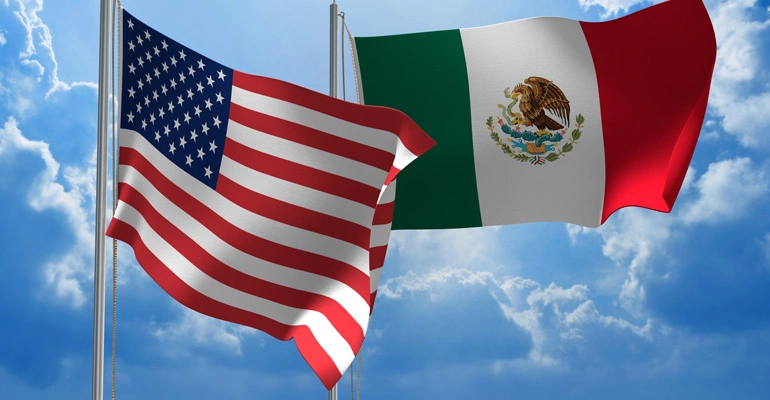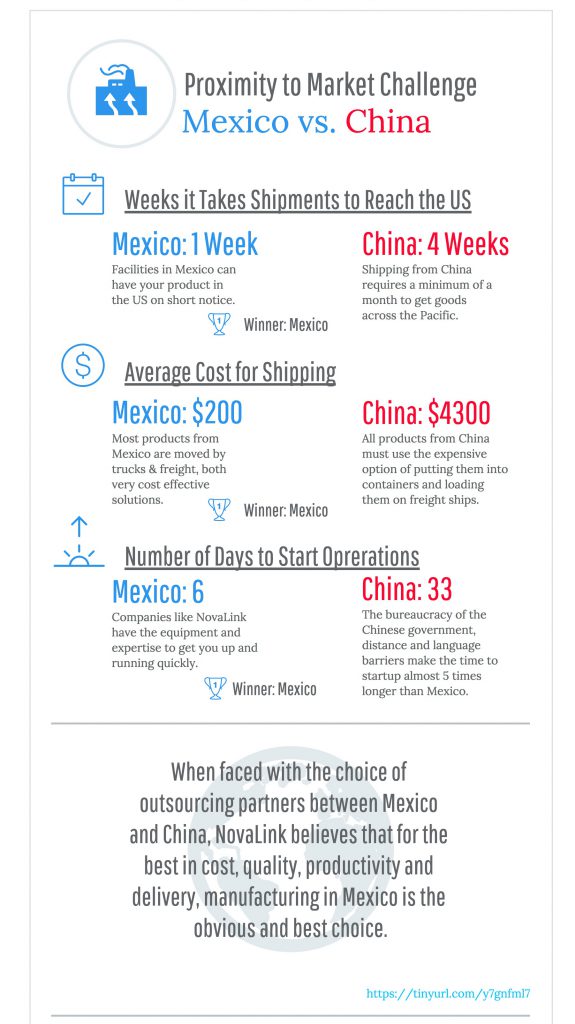Last Updated on April 3, 2025

For American manufacturers looking to stay competitive, the rules governing U.S.-Mexico trade laws aren't just a set of regulations—they're a massive advantage. From duty-free benefits to streamlined customs procedures, these laws make Mexico one of the most attractive places for U.S. companies to set up shop. But how do they work in your favor? Let’s break it down.
Get Near Shore Manufacturing News from NovaLink
Level up your nearshore manufacturing strategy! 🚀 Subscribe to our newsletter for exclusive insights and stay ahead of the competition. Get:
✅ Expert analysis and the latest industry trends
✅ Updates on new blogs, videos, and resources
✅ Essential tools to drive your success
By submitting this form, you are consenting to receive marketing emails from: NovaLink. You can revoke your consent to receive emails at any time by using the SafeUnsubscribe® link, found at the bottom of every email. Emails are serviced by Constant Contact
NAFTA's Legacy and the USMCA's Rise
If you’ve been in manufacturing for a while, you probably remember NAFTA. It laid the groundwork for trade between the U.S., Mexico, and Canada, cutting tariffs and making cross-border commerce easier. But times changed, and in 2020, NAFTA was replaced by the United States-Mexico-Canada Agreement (USMCA), which fine-tuned trade laws to be even more beneficial for American businesses.
So, what’s the big deal? For one, USMCA increased the percentage of North American-made content required in goods like cars and machinery to qualify for tariff-free trade. This means if your supply chain is largely in North America, you’re in a great spot.

Source: National Association of Manufacturers. NAM Releases USMCA State Data Sheets
USMCA
According to Investopedia, USMCA is “…a trade deal between the three nations which was signed on November 30, 2018. The USMCA replaced the North American Free Trade Agreement (NAFTA), which had been in effect since January of 1994. Under the terms of NAFTA, tariffs on many goods passing between North America’s three major economic powers were gradually phased out.”
There are many reasons why USMCA is significant, but the most important reason is the ability to save money for US businesses. Tariffs have been reduced between the nations; investments have been encouraged in North American industrial buildings, and international markets have been opened. The USMCA provides duty-free treatment for goods that qualify under its rules of origin, which avoid two percent tariffs.
The USMCA has also significantly strengthened U.S. supply chains. COVID-19 and increasing competition with China have highlighted the vulnerability of relying on Chinese supply chains. According to the Brookings Institute:
“The significance of USMCA is clear. Canada and Mexico are the United States’ largest export markets: 23 percent of U.S. exports go to Canada and Mexico (versus 5 percent to China), over 70 percent of Mexican exports are sent to the U.S. and Canada, and 62 percent of Canadian exports are to the U.S. and Mexico. Trade among the countries provides key inputs into regional supply chains’ value added (40 percent U.S. value add versus 5 percent China). “
Duty-Free Benefits: Keeping Costs Low
One of the biggest perks of U.S.-Mexico trade laws is duty-free imports and exports. Under the USMCA, many products can move between the two countries without tariffs, as long as they meet specific origin requirements.
This is especially useful for manufacturers using Mexico as a key production hub. You can import raw materials, assemble products, and send them back to the U.S. without hefty import duties eating into your margins. Essentially, you get lower production costs while keeping your supply chain close to home.
Simplified Customs Procedures: Less Red Tape, More Efficiency
If you’ve ever dealt with complex international shipping, you know paperwork and delays can be a nightmare. Thankfully, U.S.-Mexico trade agreements have tackled this head-on by simplifying customs procedures.
- Electronic documentation speeds up border crossings, reducing downtime.
- De minimis thresholds allow certain goods to enter duty-free without excessive paperwork.
- Harmonized regulations ensure that U.S. and Mexican customs follow similar standards, making compliance easier.
All of this means fewer headaches and faster turnaround times.
While C-TPAT (Customs-Trade Partnership Against Terrorism) and FAST (Free and Secure Trade) certifications are not strictly required for shipping freight across the US-Mexico border, they offer significant advantages for companies involved in cross-border trade. - Averitt
Stronger Intellectual Property Protections
For companies producing proprietary goods, intellectual property (IP) protections are important. The USMCA introduced stronger safeguards to ensure American companies' patents, trademarks, and copyrights are protected when manufacturing in Mexico. This makes outsourcing safer, reducing counterfeiting or unauthorized production risk.
Labor Cost Savings Without the Compliance Hassles
You might wonder-why not outsource to Asia, where labor costs are (somewhat) lower? While countries like China and Vietnam may offer cheaper labor, they come with significant trade-offs: tariffs, shipping costs, and regulatory headaches.
Mexico, on the other hand, offers affordable wages but also a workforce trained to meet U.S. standards. Thanks to trade agreements, American manufacturers in Mexico don’t have to navigate wildly different labor laws. The USMCA enforces fair labor standards while still allowing businesses to benefit from lower operational costs.
Faster Supply Chains: Nearshoring Beats Offshoring
The COVID-19 pandemic exposed how fragile global supply chains can be. Manufacturers that relied on distant suppliers in Asia faced massive delays, skyrocketing shipping costs, and supply shortages. That’s where Mexico shines.
By moving production closer to home companies can cut shipping times from weeks to just a few days. Plus, with ongoing tensions between the U.S. and China, many businesses find Mexico offers a more stable and predictable alternative.

Environmental and Sustainability Perks
Another hidden benefit of U.S.-Mexico trade laws? They support greener manufacturing. Shorter shipping routes mean lower carbon emissions, and with USMCA provisions encouraging sustainable practices, manufacturers have an easier time staying compliant with evolving environmental regulations.
Conclusion
U.S.-Mexico trade laws aren’t just policies on paper—they’re real advantages that can make American manufacturers more competitive. From lower tariffs and faster customs procedures to stronger IP protections and labor savings, these laws create an ideal environment for production just across the border. If you’re looking to expand, relocate, or streamline your manufacturing operations, Mexico isn’t just a viable option—it might be your best one.
FAQs on How U.S.-Mexico Trade Laws Favor American Manufacturers
1. What are the main advantages of U.S.-Mexico trade laws for manufacturers? U.S.-Mexico trade laws reduce tariffs, simplify customs processes, protect intellectual property, and allow businesses to take advantage of lower labor costs while keeping their supply chains close.
2. How does the USMCA differ from NAFTA for manufacturers? The USMCA increased regional content requirements, strengthened labor and environmental protections, and introduced stricter intellectual property rules to make trade even more beneficial for American businesses.
3. Can American companies manufacture in Mexico without paying import duties? Yes, as long as products meet USMCA rules of origin, they can be imported and exported duty-free between the U.S. and Mexico.
4. Why is nearshoring to Mexico better than offshoring to Asia? Nearshoring reduces shipping costs and times, minimizes tariff risks, and ensures compliance with U.S. regulations while still benefiting from lower labor costs.
5. How do U.S.-Mexico trade laws impact sustainability in manufacturing? Shorter supply chains lower carbon footprints, and USMCA provisions encourage sustainable practices, making it easier for manufacturers to meet environmental regulations.
Explore More: Discover Related Blog Posts
Expand your knowledge and delve deeper into more information about Trade Tariffs with our curated collection of related blog posts.
- Tariffs in Mexico vs. Taxes: What’s the Real Difference, and Why Should You Care?
- Why Mexico Is Beating Asia for Fast Turnaround
- What You Need to Know About Sourcing Fabrics in Mexico for Clothing Production
- Bill of Lading Explained: Essential Guide to Types, Terms, and How It Impacts Your Manufacturing Operations in Mexico
- How U.S. Tariffs Are Reshaping Mexico’s Manufacturing Outlook
About NovaLink
As a manufacturer in Mexico, NovaLink employs a unique approach that transcends the traditional model of shelter production. More than just the location of your manufacturing, we would like to become a partner in your manufacturing in Mexico. You will be able to relocate or initiate manufacturing for your company in Mexico in a low-cost labor environment with very little delay or up-front costs. Find out how we can help you by handling the manufacturing process.
There are NovaLink facilities in the border cities of Brownsville, Texas, Matamoros, Mexico, and Saltillo, Mexico.